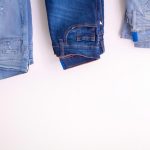When you're dealing with waffle terry, choosing the right sewing techniques can significantly impact the final product. You'll find that using a walking foot and a ballpoint needle can make a world of difference, ensuring a smooth sewing experience without damaging the fabric's unique texture. Remember to secure your layers correctly and keep seam bulk to a minimum. But what about those finishing touches that can elevate your project even further? Let's explore some strategies that might just redefine how you approach this versatile fabric.
Table of Contents
Understanding Waffle Terry Fabric
Waffle terry fabric is a unique material characterized by its textured, absorbent surface, making it ideal for bathrobes and towels. When you're working with waffle terry, you'll notice its distinctive grid-like pattern, which not only adds visual appeal but also enhances its functionality.
The fabric's softness and moisture-wicking properties ensure it feels luxurious against your skin while effectively absorbing water.
Knowing how to handle waffle terry is key. Its texture can make it a bit challenging to sew.
You might find that the fabric tends to pucker or shift if you don't use the right techniques. It's best to use a walking foot on your sewing machine to keep the layers aligned and reduce any slipping.
Additionally, consider using a stretch needle, which allows for cleaner stitching and reduces the chance of snagging the fabric.
When cutting, don't forget to use sharp scissors, as this can make a significant difference in how clean your edges turn out.
Understanding these properties will help you achieve professional-quality results in your sewing projects with waffle terry, whether you're creating cozy robes or plush towels.
Essential Tools and Materials
To achieve the best results when sewing with waffle terry, you'll need a few essential tools and materials tailored to its unique properties. Start with a good quality sewing machine that's equipped to handle thicker fabrics. A walking foot is crucial, as it helps you manage the fabric layers more effectively and prevents slipping.
You'll also want to choose the right needle. A size 90/14 universal needle works well for most waffle terry projects, but make sure it's sharp to avoid snagging the loops. For thread, opt for a polyester or cotton blend, which offers strength and flexibility.
Don't forget about pins or clips—they'll help hold everything in place without damaging the fabric. Rotary cutters and mats are excellent for cutting, giving you cleaner edges. Finally, consider using a fabric stabilizer when necessary, as it can provide extra support during sewing, especially for detailed or intricate designs.
With these tools and materials at your disposal, you'll be well-prepared to tackle any waffle terry project with ease and confidence.
Prepping Your Fabric
Start by prewashing your waffle terry to remove any shrinkage and set the fabric for your project. This crucial step ensures your final piece maintains its shape and size, avoiding any surprises after it's complete. Use cold water and a gentle cycle to preserve the fabric's unique texture.
Once you've prewashed, lay the fabric flat to dry, avoiding any forced heat that might distort it. After drying, iron the fabric on a low setting if needed; this can help eliminate any wrinkles that could interfere with your sewing.
Here's a quick reference table to guide you through prepping your waffle terry:
| Step | Details |
|---|---|
| Prewash | Cold water, gentle cycle |
| Drying | Lay flat to prevent distortion |
| Ironing (if needed) | Low heat setting to avoid damage |
Sewing Techniques for Waffle Terry
After prepping your fabric, you'll find that sewing techniques specifically suited for waffle terry can make a significant difference in achieving a polished finish.
First, use a walking foot to evenly feed the fabric through your sewing machine, preventing stretching or distortion of the texture. It's also wise to choose a ballpoint needle; this helps to slide between the fibers without causing snags.
When sewing seams, opt for a straight stitch rather than a zigzag to keep your seams clean and reduce bulkiness. If you're working on curved areas, a small zigzag stitch can offer some flexibility without compromising the integrity of the fabric.
Be sure to keep your stitch length between 2.5-3 mm for optimal results. Waffle terry can shift, so pin or use fabric clips to secure layers in place as you sew.
Lastly, press your seams gently, using a low heat setting, to avoid damaging the fabric's texture. These techniques will help you create beautiful, functional items from waffle terry, ensuring your project not only looks great but lasts.
Finishing Touches and Care
Finishing your waffle terry project with attention to detail ensures a professional appearance and durability.
Start by trimming any excess thread for a clean look. Then, consider serging or zig-zagging the raw edges to prevent fraying, especially if you plan to wash your item frequently.
For hems, fold your fabric twice to encase the raw edge, and use a straight stitch for a polished finish. A double needle can give your hems a neat, decorative touch, enhancing the overall aesthetic of your project.
Once your item is complete, it's essential to care for it properly. Waffle terry is generally machine washable, but you should always check the care label for specific instructions.
When washing, use cold water and a gentle cycle to preserve the fabric's texture and color. Avoid bleach, as it can damage the fibers.
Air drying is ideal, as it helps maintain the fabric's loft. If you're using a dryer, opt for a low heat setting.
Finally, ironing isn't usually needed, but if you do, use a low steam setting to avoid flattening the waffle texture.
These finishing touches and care tips will help your waffle terry project last.
Frequently Asked Questions
Can I Use a Regular Sewing Machine for Waffle Terry?
Yes, you can use a regular sewing machine for waffle terry. Just ensure you have the right needle and thread. Adjust your tension settings and use a walking foot for smoother feed through the machine.
Are There Specific Needle Types Recommended for Waffle Terry?
When sewing waffle terry, you'll want to use a ballpoint needle, as it easily slides between fibers without causing snags. A size 10/70 or 11/80 needle will work well, giving you smooth, efficient results.
How Do I Prevent Fabric Distortion While Sewing?
To prevent fabric distortion while sewing, you should use the right needle, maintain an even tension, and support the fabric as you sew. Always guide the fabric gently to avoid stretching or pulling.
What's the Best Way to Wash Waffle Terry After Sewing?
To wash waffle terry after sewing, you should use cold water and a gentle cycle. Avoid fabric softeners; they can affect the texture. Air dry or tumble dry on low for best results. Enjoy your creation!
Can I Dye Waffle Terry Fabric, and How?
Yes, you can dye waffle terry fabric! Use fiber-reactive dyes for the best results. Just prewash the fabric, dissolve the dye in hot water, and follow the manufacturer's instructions for dyeing techniques and timing.
- How Does Ring Spun Cotton Affect Garment Fit and Shape Retention? - August 13, 2024
- What Are the Challenges in Producing Ring Spun Cotton? - August 13, 2024
- Is Ring Spun Cotton Suitable for Plus-Size Clothing? - August 13, 2024







